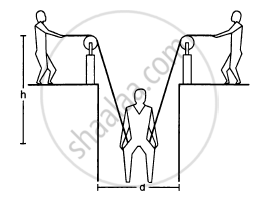Advertisements
Advertisements
Question
A body of mass 2 kg travels according to the law x(t) = pt + qt2 + rt3 where p = 3 ms−1, q = 4 ms−2 and r = 5 ms−3. The force acting on the body at t = 2 seconds is ______.
Options
136 N
134 N
158 N
68 N
Solution
A body of mass 2 kg travels according to the law x(t) = pt + qt2 + rt3 where p = 3 ms−1, q = 4 ms−2 and r = 5 ms−3. The force acting on the body at t = 2 seconds is 136 N.
Explanation:
Given, mass = 2 kg
`x(t) = pt + qt^2 + rt^3`
`v = (dx)/(dt) = p + 2qt + 3rt^2`
`a = (dv)/(dt) = 0 + 2q + 6rt`
At t = 2s; a = 2q + 6 × 2 × r
= 2q + 12r
= 2 × 4 + 12 × 5
= 8 + 60
= 68 m/s
Force = F = ma
= 2 × 68
= 136 N
APPEARS IN
RELATED QUESTIONS
A block of mass 15 kg is placed on a long trolley. The coefficient of static friction between the block and the trolley is 0.18. The trolley accelerates from rest with 0.5 ms–2 for 20 s and then moves with uniform velocity. Discuss the motion of the block as viewed by (a) a stationary observer on the ground, (b) an observer moving with the trolley.
A car accelerates on a horizontal road due to the force exerted by.
A man has fallen into a ditch of width d and two of his friends are slowly pulling him out using a light rope and two fixed pulleys as shown in the following figure. Show that the force (assumed equal for both the friends) exerted by each friend on the road increases as the man moves up. Find the force when the man is at a depth h.
In the previous problem, suppose m2 = 2.0 kg and m3 = 3.0 kg. What should be the mass m, so that it remains at rest?
A body of mass 5 kg is moving with velocity 2 m s-1. Calculate its linear momentum.
How long will a stone take to fall to the ground from the top of a building 80 m high
A pebble is dropped freely in a well from its top. It takes 20 s for the pebble to reach the water surface in the well. Taking g = 10 m s-2 and speed of sound = 330 m s-1. Find : The time when echo is heard after the pebble is dropped.
Multiple Choice Question. Select the correct option.
Which of the following are vector quantities?
Name the physical entity used for quantifying the motion of a body.
A metre scale is moving with uniform velocity. This implies ______.
